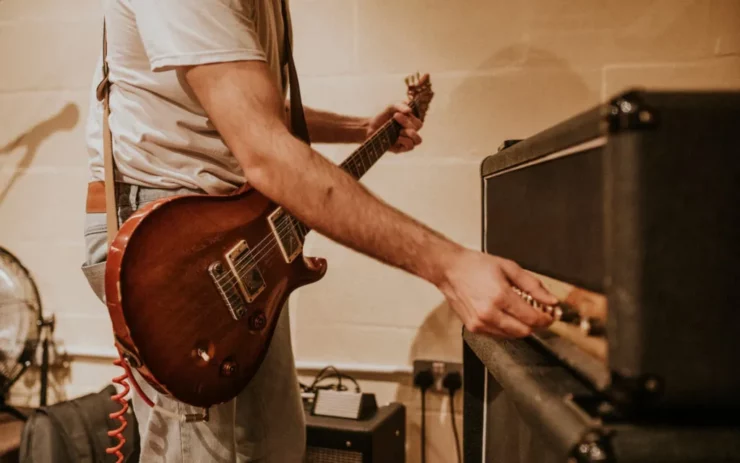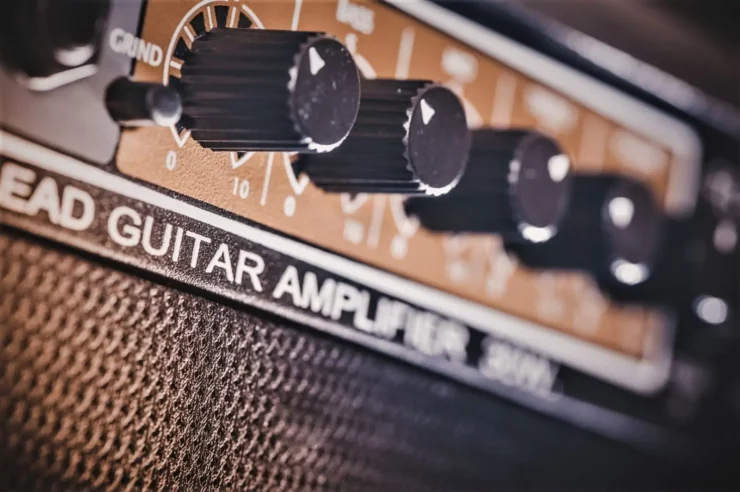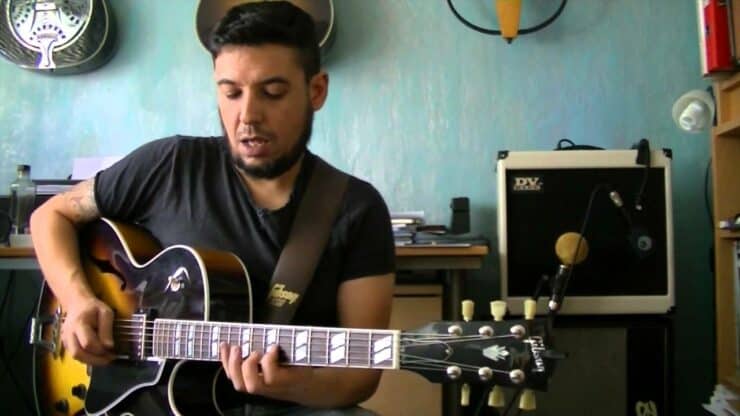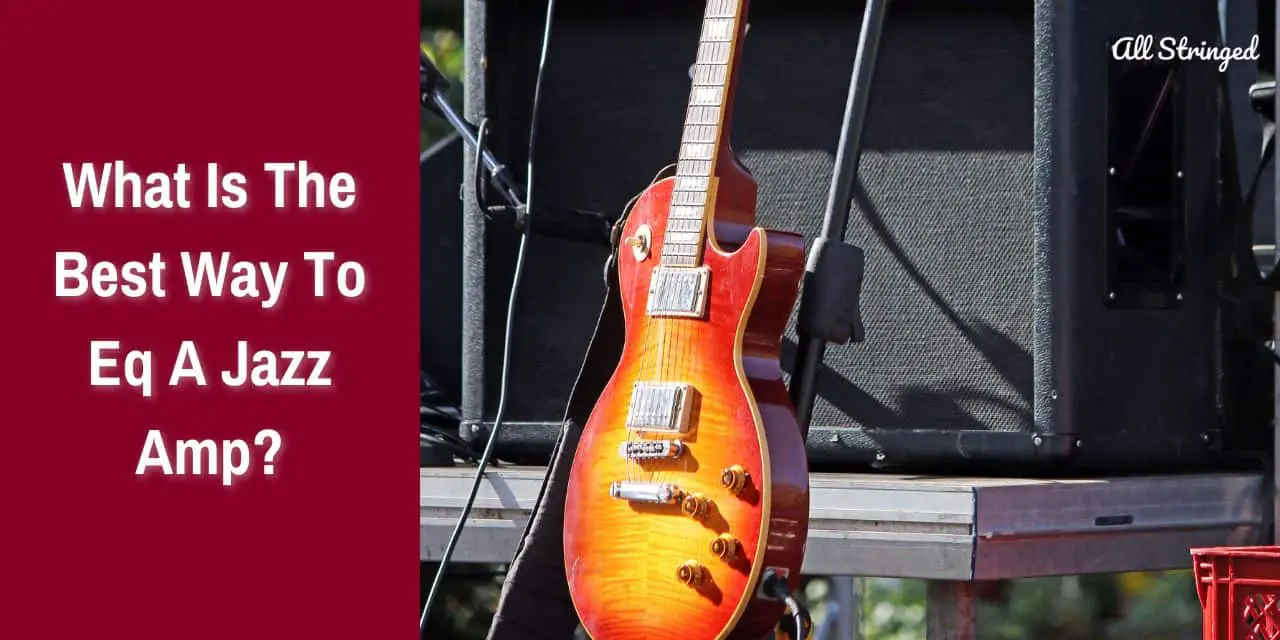As a guitar player, have you ever wondered what the best way to EQ a jazz amp is? If you’re looking for the answer to this question, you’ve come to the right place. In this article, we’ll explore the different factors to consider when EQing a jazz amp, and discuss the best practices for achieving the perfect sound. Read on to learn more, and get ready to take your jazz tone to the next level.
What is EQ?
In the world of music production and audio engineering, EQ stands as one of the most fundamental and powerful tools. Short for “Equalization”, EQ plays a key role in shaping the tonal characteristics of sound, enhancing the auditory experience, and creating balanced, harmonious compositions.
>>> Click here to read our review about the Top 15 Best Jazz Amps <<<
At its core, EQ refers to the process of adjusting and modifying the balance between different frequencies within an audio signal. These frequencies encompass the entire range of audible sounds, from deep bass tones to high-pitched trebles. By manipulating the amplitude or volume of specific frequencies, EQ will empower audio engineers, producers, and musicians to sculpt sound in a precise and intentional manner.
EQ involves a number of key elements, each contributing to the overall tonal balance. This includes frequency bands, gain, and Q factor.
Frequency bands
EQ typically divides the frequency spectrum into various bands, such as low, mid, and high. These bands represent specific ranges of frequencies, allowing for targeted adjustments.
Gain
The gain control adjusts the amplitude of the selected frequency band. It can boost or cut the volume, enhancing or reducing the prominence of certain frequencies.

Q factor or bandwidth
This parameter will determine the width of the frequency band affected by the EQ adjustment. A narrow bandwidth focuses on a specific range whereas a wider one will affect adjacent frequencies too.
EQ finds applications in different stages of music production and audio engineering. During recording, EQ can help in capturing an instrument’s natural timbre and compensate for room acoustics. In mixing, it will allow engineers to place each element within the sonic spectrum, ensuring clarity and preventing muddiness.
EQ balances the frequencies of different instruments and vocals, preventing one element from overpowering the others. This balance enhances the overall sonic quality of a track. Musicians and producers make use of EQ as a creative tool for achieving specific timbral effects. Boosting certain frequencies can add warmth or brilliance whereas cutting frequencies can create a sense of distance or space.
EQ can address sonic issues like unwanted resonances, harshness, or boominess. By identifying problematic frequencies, engineers will be able to make corrective adjustments to improve the sound.
How does EQ affect sound in guitar?
The guitar, with its soulful strums and electrifying solos, is a versatile instrument that has found its way into virtually every genre of music. While the guitar’s inherent tonal character is captivating, the art of shaping its sound lies in the realm of equalization (EQ). EQ is the key to unlocking a guitar’s full sonic potential, influencing its timbre, presence, and overall impact.
Role of EQ in guitar sound
Equalization in the context of guitars involves manipulating different frequency bands to achieve a desired sonic outcome. Whether you are aiming for a warm acoustic resonance, a searing rock crunch, or a sparkling clean tone, EQ plays a major role in sculpting the sounds to match your artistic vision.
The frequency spectrum encompasses the range of audible frequencies that contribute to the guitar’s sound. The frequencies add depth and weight to the guitar’s sound. They are crucial for establishing the foundation of the tone, especially in genres like jazz. The midrange frequencies are where much of the guitar’s character resides. Adjusting the mids can make the guitar sound more forward or recessed in the mix. Moreover, it heavily influences the guitar’s presence and definition. High frequencies add sparkle, brilliance, and clarity to the guitar’s sound. They contribute to the articulation of individual notes and play a major role in achieving the “crisp” tone associated with lead guitar solos.
Apply EQ to different types of guitars
Different types of guitars, such as acoustic, electric, and bass guitars come with distinct sonic characteristics that can be enhanced or modified through EQ.
Adding a slight boost to the low frequencies can enhance the body and resonance of an acoustic guitar, making it sound fuller and warmer. Boosting the high frequencies will emphasize the shimmering qualities of an acoustic guitar, enhancing its clarity and brilliance.
EQ is important for shaping the tone of distorted electric guitars. Cutting certain mid frequencies can reduce muddiness while boosting others could enhance the bite and aggression of the tone. For clean electric guitar tones, EQ can emphasize the natural character of the instrument. Boosting the mid frequencies can add presence and definition.
Bass guitars rely heavily on low frequencies for their power and depth. Boosting the low end can make the bass guitar sound more robust and impactful. While boosting lows, it is important to ensure that the midrange frequencies remain clear to maintain the bass guitar’s articulation and definition.
Achieve balance and presence
EQ in guitars is all about achieving balance and presence in the mix. Cutting excessive low-mid frequencies can remove muddiness and unwanted resonance, allowing the guitar to sit well in the mix.
Notching out harsh frequencies can smooth out the guitar’s sound, preventing it from becoming piercing or abrasive. Different fretboard positions can produce varying levels of brightness or warmth. EQ adjustments can help maintain consistency across the fretboard.

What is the best way to EQ a jazz amp?
In the realm of jazz music, the tone of your instrument will be the canvas upon which you’ll be painting your emotions and creativity. When it comes to jazz guitar amps, mastering the art of equalization (EQ) is paramount. EQ is the key to achieving the warm, resonant, and articulate sound that characterizes jazz guitar.
#1. Setting the foundation with bass, mid, and treble
Bass frequencies offer the foundation of your sound. They can add depth and warmth to the tone, giving it body and resonance. You must start by setting the bass knob to a moderate level. Too much bass could muddy the sound so aim for a balance that maintains clarity while adding richness.
The mid frequencies are where the guitar’s character resides. They determine how your guitar sits in the mix and affect its presence and definition. Experiment with the mid knob for finding a balance that suits the style and mood of your jazz playing. A slight boost in the midrange can enhance articulation and cut through without becoming too aggressive.
For treble, high frequencies will add brilliance and clarity to the sound. They affect the guitar’s articulation and help it cut through the mix. Adjust the treble knob to achieve the desired amount of sparkle and definition. Be cautious that you do not overdo it as excessive treble could result in an overly bright or harsh sound.
#2. Shaping presence for projection
The presence control adds a sense of immediacy and projection to your sound. It influences the upper midrange frequencies. Gradually adjust the presence knob for finding the sweet spot that enhances the guitar’s projection without making it too shrill or strident.
#3. Using EQ to sculpt the sound
You must listen carefully for any frequencies that sound unpleasant, harsh, or muddy. Moreover, you can also use the EQ controls to cut or attenuate these problematic frequencies. This can involve a narrow cut in the midrange to eliminate nasal quality or a reduction in the low end to avoid muddiness.
Boosting specific frequencies will enhance the character of your jazz guitar. For example, a gentle boost in the upper midrange can add warmth and body to your sound. Experiment with subtle boosts to accentuate harmonics or add unique color to your tone. However, you must be cautious that you don’t overdo it, as excessive boosting can lead to an unbalanced or unnatural sound.
#4. Experimentation and adaptation
You must consider the acoustics of the room you are playing in as it can affect how your guitar amp sounds. Adjust the EQ settings accordingly to adapt to the environment. Remember that different guitars interact differently with amps. Your EQ settings may require slight adjustments when you switch guitars. Lastly, trust your years as you make EQ adjustments. Listen critically and make incremental changes for achieving the desired sound.
Different types of EQ in guitar amps
The world of guitar amps is a realm of sonic possibilities, where the right combination of settings can transform your sound from subtle to explosive. In this realm, Equalization or EQ reigns supreme as a tool for shaping the tone. There are different types of EQ that offer distinct approaches to sculpting your sound. Here are the different types of EQ and their roles in the world of guitar amplification.
Graphic EQ
Graphic EQ is characterized by a set of sliders, each representing a specific frequency band. These bands are evenly spaced across the audible frequency spectrum. The visual representation of sliders will provide a clear overview of frequency adjustments.
With dedicated bands, you will be able to precisely boost or cut specific frequency ranges. Once set, the position of the sliders will ensure consistency across different settings.
Graphic EQ is typically found in amps that cater to a wide range of genres. It allows guitarists to tailor their tone to match different playing styles and venues. If you are looking for straightforward frequency adjustments and require quick tonal changes to suit different settings, then you must choose a graphic EQ.
Parametric EQ
Parametric EQ offers greater control by providing adjustments for frequency, bandwidth, and gain. It allows you to target specific frequencies and shape them with precision. Parametric EQ will let you zero in on the problem frequencies or enhance specific tonal characteristics.
The bandwidth control allows you to adjust how wide or narrow the affected frequency range is. Parametric EQ will offer a more surgical approach to tone shaping, preserving the natural sound of your guitar.
Parametric EQ is favored by tone connoisseurs and those seeking highly nuanced adjustments. It is often found in amps where players demand intricate control over their sound. You must opt for a Parametric EQ if you are a tone enthusiast if you wish to have complete control over your sound, with the ability to target and fine-tune specific frequencies.
Semi-parametric EQ
Semi-parametric EQ combines the visual simplicity of a graphic EQ with the precision of a parametric EQ. It offers fewer controls compared to a full parametric EQ.
Semi-parametric EQ allows users to control specific frequencies while maintaining user-friendly operation. The presence of limited control makes it less overwhelming for guitarists who want customization without delving into intricate settings.
Semi-parametric EQ is an excellent choice for guitarists who seek a balance between control and simplicity. It is often found in versatile amps designed to accommodate a range of playing styles. If you are looking for a balance between precise adjustments and ease of use, a semi-parametric EQ will be a versatile choice that offers selective control without overwhelming complexity.
Important tips for EQing a jazz amp
Jazz music is a world of intricate melodies, rich harmonies, and expressive improvisations. In the realm of jazz music, the nuances of tone are as important as the melodies and harmonies that define this genre. Within this genre, the right tone is important for conveying the emotions and nuances of the music. Equalization or EQ is your tone of choice that stands as a potent way to shape the sonic palette of jazz guitar amps. It helps shape the perfect jazz tone that resonates with warmth, clarity, and versatility. It is the bridge between the player’s emotions and the audience’s ears, allowing you to fine-tune the sound to perfection. Here are some of the important tips you must remember as they’ll help in EQing a jazz amp, allowing you to craft a tone that is warm, expressive, and uniquely yours.
#1. Start with a clean slate
Before you delve into EQ adjustments, reset all knobs to their neutral or flat positions. This will provide you with the baseline from which to begin your sonic exploration. A blank slate will ensure that any adjustments you make are intentional and responsive to your desired sound.
#2. Create a warm tone
Warmth is a hallmark of jazz guitar tones, evoking a sense of nostalgia and comfort. EQ can help in achieving this inviting quality by enhancing specific frequency ranges. Slightly boosting the lower frequencies will add body and resonance to your sound, creating a foundation of warmth.
Gently boost the mid frequencies as it will add presence and articulation to your playing, allowing your notes to sing. Jazz tones often benefit from a reduction in harsh high frequencies. Slight cuts in the upper treble range can soften your sound without sacrificing clarity.
#3. Set the tone for different types of jazz
In smooth jazz, a midrange-focused EQ enhances the silky qualities of your tone. Boost the mids for a round, expressive sound. Bebop and traditional jazz demand a balanced tone. You need to avoid extreme boosts or cuts and maintain a midrange emphasis to allow your instrument’s natural character to shine.
Fusion jazz often involves intricate solos and fast-paced playing. You need to boost the mid frequencies to cut through the mix and slightly increase the treble for added bite. Modal and contemporary jazz emphasizes clean, clear tones. You need to prioritize midrange clarity and a balanced EQ to let the chords and melodies ring out.

#4. Make use of the amp’s versatility to get a dynamic jazz tone
If your jazz repertoire spans multiple styles, you must consider saving EQ presets for each genre. This will allow you to switch between different tones seamlessly. Make use of semi-parametric EQ controls to pinpoint and adjust specific frequencies. This level of precision will be important for achieving the distinct qualities of different jazz styles.
#5. Achieve balance and definition
Achieving a balanced and defined tone will be important for any style of jazz. You can use EQ for ensuring your guitar cuts through the mix without overpowering by utilizing careful midrange boost, subtle treble enhancement, and trim excesses.
A moderate midrange boost will enhance articulation and ensure your guitar’s voice is heard without being too dominant or forward. A slight treble boost will add sparkle and brilliance to your sound. The subtle enhancement will enhance definition and articulation. Use narrow cuts for addressing any resonant or harsh frequencies that detract from the smooth character of your jazz tone.
#6. Adapt to the venue and ensemble
Different venues and ensemble sizes can affect how your jazz tone is perceived. You must consider these EQ adjustments for adapting to varying situations. Boosting the midrange can help your guitar stand out in a solo performance, allowing your intricate lines to shine through.
In a larger ensemble, where multiple instruments share the sonic space, a more balanced EQ ensures your guitar complements rather than competing with other instruments. Pay close attention to the room’s acoustics. If the space is particularly resonant, you must consider reducing frequencies that exacerbate the room’s natural reverb.
#7. Experiment and listen intently
EQ adjustments are as much an art as they are a science. The right way to approach this situation would be through experimentation and finesse. Begin with all the EQ knobs set to the flat or neutral position. This will serve as a foundation for your tone-shaping journey.
Experiment with various EQ settings while listening attentively. Make small adjustments and give your ears ample time to adapt to the changes. Moreover, making small adjustments to your EQ settings will help you discern the effects accurately.
Record yourself playing with different EQ settings and listen back to assess the nuances. This way, you will be able to compare the recordings. This objective analysis will help you identify which adjustments are best to capture the jazz sound you are looking for.
#8. Study and seek inspiration from masters
Study the jazz greats who have played a pivotal role in defining this genre. Listen to their recordings and pay close attention to their tone. While replicating their sounds is not always the goal, their tones can serve as a source of inspiration as you develop your unique jazz sound.
FAQs
What is EQ and why is it important for jazz amps?
EQ (equalization) is the process of adjusting the frequency balance of an amplifier’s sound to achieve a desired effect. When it comes to jazz amps, EQ is important to help shape the sound of the amp in order to produce the desired jazz tones. EQ can be used to boost certain frequencies, cut certain frequencies, or both, depending on what type of sound you are looking for.
What are some tips for EQing a jazz amp?
When EQing a jazz amp, it’s important to focus on the mids and low-end frequencies to give it a warm and full sound. It’s also important to be careful not to over-boost the high frequencies as this can make the amp sound too bright. Additionally, it’s helpful to experiment with different settings until you find the sound you are looking for.
What type of EQ should I use for my jazz amp?
The type of EQ you should use for your jazz amp depends on the type of amp you are using. Most modern amps come with built-in EQ settings that you can adjust to achieve the desired sound.



